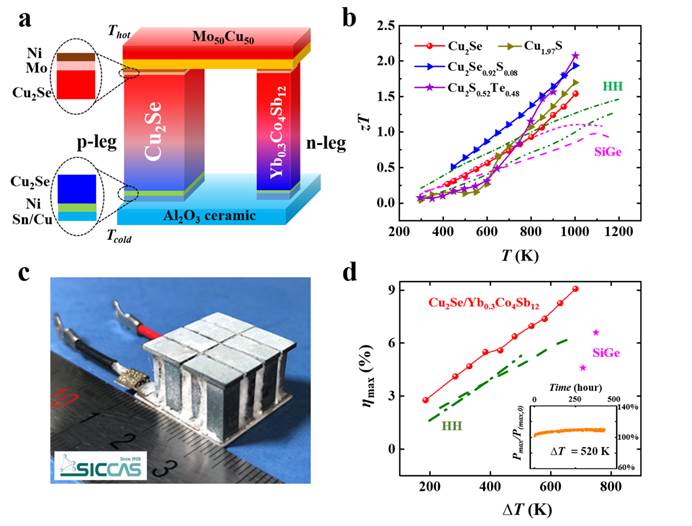- Home
- About Us
- News
-
Research
- State Key Laboratory of High Performance Ceramics
- State Key Laboratory of Functional Crystals and Devices
- The Frontier Department
- Structural Ceramics and Composite Materials
- Information Functional Materials and Devices
- Inorganic Coating Materials
- Artificial Crystal
- Transparent Ceramics
- Energy Materials
- Biomaterials and Tissue Engineering
- Ancient Ceramics and Industrial Ceramics
- Pilot Test for New Materials
- People
- International Cooperation
- Education
- Journals
- Links
【embargo 5月23日11:00AM Eastern time US】Scientists Develop High Efficiency and Stable Thermoelectric Module Based on High-performance Liquid-like Materials
Based on high-performance liquid-like materials, the Cu2Se/Yb0.3Co4Sb12 thermoelectric module including eight n-type Ni/Ti/Yb0.3Co4Sb12 legs and eight p-type Ni/Mo/Cu2Se legs is innovatively fabricated. A high energy conversion efficiency up to 9.1% and excellent service stability are reported in Joule. Such strategy goes beyond the normal design of TE modules based on the traditional TE materials, under the joint cooperation between the scientists from the Shanghai Institute of Ceramics, Chinese Academy of Sciences and the Northwestern University of US.
Thermoelectric technology can realize direct conversion between heat and electricity. Due to the advantages of no noisy, no moving part, and high reliability, it has attracted great attentions as an alternative way to high-efficiently utilize energy.
The usual design of thermoelectric module based on traditional materials only needs to realize high efficiency or high-power output through optimizing material leg’s geometry and interfaces. However, the liquid-like ions presents a new challenge. Beyond the high energy conversion efficiency or high-power output, the service stability must be included in the design of thermoelectric module based on liquid-like materials.
During the service, the voltage across liquid-like materials (Va) is directly related with the ratio of cross-sectional areas of p- and n-legs (Ap/An). If the liquid-like material is p-type, the larger Ap/An will lead to the smaller Va and consequently better stability during service.
Two kinds of TE modules based on liquid-like materials are developed. Cu2Se and Cu1.97S are chosen as the p-type legs, and Yb0.3Co4Sb12 filled skutterudite was selected as the n-type legs. The Cu1.97S/Yb0.3Co4Sb12 TE module is not stable during service. However, the Cu2Se/Yb0.3Co4Sb12 TE module is quite stable when the Ap/An is higher than 4. The three-dimensional numerical analysis shows that the high energy conversion efficiency requires the Ap/An between 2 and 8. Thus, the Ap/An values of 4-8 are required to simultaneously maximize conversion efficiency and achieve good stability.
A maximum energy conversion efficiency for the Cu2Se/Yb0.3Co4Sb12 thermoelectric module reaches 9.1%, a record-high energy conversion efficiency among the high temperature thermoelectric modules. The long-term aging test confirmed the good stability of the module. This strategy can be also used to design new TE module based on other liquid-like materials such as Ag9GaSe6 and Zn4Sb3.

Figure 1. a, Schematic drawing of a Cu2Se/Yb0.3Co4Sb12 TE couple used in the module. b, Temperature dependence of TE figure of merit (zT) for several typical liquid-like TE materials. c, Optical image of the eight-couple Cu2Se/Yb0.3Co4Sb12 TE module. d, Maximum TE conversion efficiency (ηmax) as a function of temperature gradient (△T) for the Cu2Se/Yb0.3Co4Sb12 module.
Reference:
Contact:
Prof. SHI Xun, Prof. CHEN Lidong
Shanghai Institute of Ceramics
xshi@mail.sic.ac.cn



